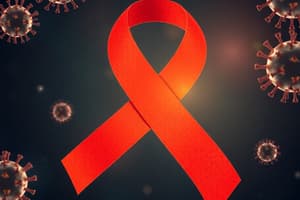Podcast
Questions and Answers
HIV
HIV
Type: retrovirus, has RNA genome and RNA dependent DNA polymerase termed reverse transcriptase Pathogenesis: targets immune system by forming amounts of progeny virus in vivo Transmission: body fluids (sexual activity, blood transfusion, IV injection) Appear: surrounded by a lipid bilayer from host cell membrane during budding and a protein capsid with 2 identical RNA molecules Contains: proteins and glycoproteins Early Stages: viral reverse transcriptase has an error state, leading to high mutation rates that allow for viral variants to escape immune surveillance Diagnosis: saliva samples or serum to find presence of HIV antibodies
T cells in HIV
T cells in HIV
T cells: lymphocytes that play a role in adaptive immunity, helper release cytokines and cytotoxic kill directly.
HIV Pathogenesis
HIV Pathogenesis
destroys TH cells by binding to their CD4 receptor , which needs a CCR5 and CXCR4 coreceptor. Viral RNA enters the cell and fuses cell membrane with viral envelope. RNA becomes DNA and it integrated in cells and makes new viral proteins, leading to cell death, leading to proteins being released that can affect other cells
HIV ELISA components
HIV ELISA components
HIV ELISA steps
HIV ELISA steps
AIDS
AIDS
AIDS testing
AIDS testing
ELISA AIDS steps
ELISA AIDS steps
Blocking
Blocking
Flashcards are hidden until you start studying



